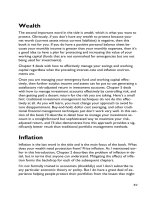everyone is a customer a proven method for measuring the value of every relationship in the era of collaborati phần 2 ppsx
Bạn đang xem bản rút gọn của tài liệu. Xem và tải ngay bản đầy đủ của tài liệu tại đây (119.11 KB, 24 trang )
xxiv Contents
The Era of
Collaborative Business
PART ONE
2 Part One
❘
Part Title
❚ Tuesday, September 11, 2001, started out like any other
summer day. But by day’s end, the world as we knew it had
changed. Forever.
W
e are living in volatile times. Uncertainty reigns. Busi-
ness patterns are changing as the result of social, po-
litical, economic, and technological developments.
Most tragically, recent global events have complicated the busi-
ness landscape in ways we have yet to fully understand.
Even before the terrorist attacks of September 11, 2001, the
global economy was undergoing a transformation felt through
consolidations and downsizings. Now we are in a phase, at least
for the foreseeable future, in which conservation of resources is
the order of the day. It seems that everything that was true about
business no longer holds.
Why? Because of two fundamental truths of the networked
economy:
3
The Collaboration
Imperative
CHAPTER 1
1. The power in business relationships has shifted to customers.
As a result . . .
2. Traditional business and industry structures are dying.
Not all businesspeople have equated these two major devel-
opments with declining sales, plummeting valuations, and soar-
ing layoffs. Others have a sense of the association and are trying
to see their way clear. Not all of the economic malaise of the years
2000 to 2002 is due to these two developments, or factors; some of
it is certainly due to the uncertainty elevated by the attacks of Sep-
tember 11. However, it would be a mistake to disregard the pro-
found impact these two factors have had. Think about it. Why
should the business and industry structures that worked during
the business-centric era be expected to work now that we are in
the customer-centric era? They shouldn’t and they don’t.
But all is not bleak. The economic transformation caused by
the ongoing shift from product-centric to customer-centric busi-
ness models resulting from rapid changes in communication and
information technologies may, in fact, turn out to be our trump
card. This shift in the balance of power in business relationships
to customers has led us to a new business paradigm that is devel-
oping across industries, embracing both customers and business
partners. It is the era of collaborative business, where commerce is
done in trading communities (what we call Collaborative Com-
munities) built by creating win-win relationships with customers
and business partners through a continuous stream of value
propositions that help each party achieve its respective goals.
❚ In the era of collaborative business, commerce is conducted
in trading communities built by creating win-win relationships
with customers and business partners.
When business is practiced in trading communities, it
changes everything about how business gets done. Every aspect
4 Part One
❘
The Era of Collaborative Business
of business is impacted—from what constitutes a business entity
and the products and services it offers to the jobs we perform
each day and how we produce value and improve company per-
formance. And most assuredly, the attacks of September 11 crys-
tallized the complex interdependencies that exist between
companies and nations and further demonstrated the necessity
to work with like-minded people to achieve shared goals and the
benefit from doing so.
THE NEED TO COLLABORATE
It is the new business mantra—collaborate, collaborate, collab-
orate. But what is collaboration and why is everyone talking
about it?
Collaboration has many meanings, depending with whom
you speak. Some call collaboration the ability to work with oth-
ers in distant locations just as you would if they were physically
across the table in the same room. For others, collaboration is
about the free flow of information across boundaries. And for
still others, it is the sharing of resources and goals.
More precisely, Merriam Webster’s Collegiate Dictionary (10th
ed.) defines collaboration as “(1) working jointly with others
with whom one is not immediately connected and (2) cooperat-
ing with, or willingly assisting, an enemy of one’s country.“
What’s interesting is that during World War I and World War II,
the word collaboration took on a sinister meaning. It was used al-
most exclusively as cooperating with the enemy, and no one
wanted to be accused of being a collaborator. But that was then.
Today, collaboration is used more positively. Both in business
and in war, collaboration is viewed as essential for success.
Collaboration is considered vital because companies and na-
tions realize that they can no longer go it alone. To survive in the
networked economy where the balance of power has shifted to
the customer, companies are learning that they must collaborate
1
❘
The Collaboration Imperative 5
with their customers and other businesses in the design, develop-
ment, and delivery of the market basket of goods and services if
they expect to profitably satisfy their customers’ personal needs.
Listen to how Bob Evans, editor-in-chief of InformationWeek,
a trade publication that made collaborative business an editorial
focus, describes the importance of collaboration in business:
The 21st century will force companies of all stripes to
collaborate aggressively and religiously, both inside the
company and outwardly with its partners. . . . More
than ever before, the intertwined worlds of business
and technology will wrap into one unified thread: busi-
ness goals and objectives outlined and defined by all
parties, metrics and milestones determined in partner-
ship, stewardship of various projects taken up by the
appropriate leaders . . . The issue—the reality—is col-
laboration. (Reprinted with permission of Information-
Week, CMP Media, Manhasset, NY)
Likewise, nations now realize that they must collaborate
with the people of other nations to survive and prosper. British
Prime Minister Tony Blair’s speech to the Labour Party confer-
ence following the September 11 attacks couldn’t have argued
more eloquently for collaboration: “Our self-interest and our
mutual interests are today inextricably woven together.”
From our point of view, we see that building the coalition to
fight terrorism resembles the new business paradigm. As U.S.
President George Bush stated in an October 11, 2001, press con-
ference: “The attack took place on American soil, but it was an
attack on the heart and soul of the civilized world. And the
world has come together to fight a new and different war.”
From this global perspective, the United States assumes the
role of what we call the “choreographer,” the entity that sees the
vision and works to bring order and direction to the movements
6 Part One
❘
The Era of Collaborative Business
of the community members, in this case the people and nations
of the world who stand opposed to terrorism.
Whether in business or in geopolitics, the choreographer’s
role is to build relationships by identifying value propositions
that could exist between and among the parties based on what
each party brings to the relationship. In building this collabora-
tion, the U.S. has structured value propositions with countries
such as Pakistan that previously supported the Taliban. Fearing
instability, Pakistan offered information about, and access to, the
Taliban and Afghanistan to the United States. In return, the
United States offered to lift previously ordered economic sanc-
tions (imposed because of the testing of nuclear weapons), and
Pakistan’s leaders hope that the lifting of sanctions will promote
prosperity and political stability by easing the hardships of the
Pakistani people.
❚ The choreographer’s role is to build relationships by identi-
fying value propositions that could exist between and among
the parties.
Certainly, value propositions between nations are fluid
and have always iterated as each nation learns more about how
the other can help it achieve its goals. In essence, what this Col-
laborative Community of nations is doing is trading cash and
non-cash currencies so that each country moves closer toward
meeting its individual goals. At the same time, the Collabora-
tive Community moves closer to meeting its shared goal of root-
ing out terrorism.
How do we even begin to comprehend what these events
will mean for us as individuals and in the way we go about
doing our jobs? What will it mean for our families, our compa-
nies, our customers, and our business partners? Where it will all
lead, we must confess we do not know. But we do know that
whatever bright future is possible, the way to work toward that
1
❘
The Collaboration Imperative 7
goal is through collaboration. Whether we are looking at busi-
ness or geopolitics, the benefits of, and the necessity for, work-
ing across traditional boundaries with like-minded people to
achieve shared goals is undeniable.
BUSINESS TRADING COMMUNITIES
In the era of collaborative business, commerce is done in
trading communities that embrace both customers and business
partners in trusting, purposeful, win-win relationships. Or
stated differently, a Collaborative Community is a seamless al-
liance of trading partners and customers where everyone bene-
fits by focusing on profitably satisfying the set of needs and
wants of the customers who define the community. It is impor-
tant to understand that regardless of whether these trading part-
ners and the competencies they bring to the community are
found in a division of General Electric or in an individual free
agent, each entity has to gain value from its participation in the
overall business structure, that is, in the community. In other
words, each of these entities must believe that the benefits of col-
laboration exceed the cost of membership. Each entity must see
a clear value proposition, just as each customer sees a clear value
proposition in a traditional customer–business relationship. In
the era of collaborative business, every relationship must be
thought of as a customer relationship.
A Collaborative Community focuses on satisfying the
needs and wants of each customer on an increasingly personal-
ized basis. Thus it requires the entity that builds the community
to have as its core competency the ability to develop a relation-
ship with, and understand the needs of, the customer. This mem-
ber must also build the alliance of business partners that provide
the additional competencies required to profitably satisfy the
customer. This member is the choreographer, as noted before in
the example of the United States–led coalition against terrorism;
the choreographer is the entity that sees the vision for the com-
8 Part One
❘
The Era of Collaborative Business
munity and works to bring order and direction to the move-
ments of the members in pursuit of their shared goals. And just
as we call this role player the choreographer, we call the give and
take of information, access, goods, services, and money between
and among the trading partners and the customers the “dance.”
Of course, one can say this dance with customers and busi-
nesses has always gone on. And certainly this is true. However,
what is different today are the profound developments in infor-
mation and communication technologies that are transforming
the relationships between and among businesses and their cus-
tomers into Collaborative Communities. As Peter Drucker said
at the Collaborative Commerce Summit in June 2001, “The great-
est impact of the Internet is the elimination of distance.” More
than ever, new technologies are allowing people at whatever dis-
tance to work closer together. And it is these new information
and communication technologies that require us as business-
people to adopt new perspectives and master new communica-
tion and relationship skills.
❚ New information and communication technologies require
new perspectives and new communication and relationship
skills.
EVERYONE IS A CUSTOMER
As companies today realize that to profitably satisfy their
customers’ needs, they must focus on what they do best and col-
laborate with both their customers and other business entities in
order to provide a complete solution, they are also realizing that
all parties involved must receive something they value for the col-
laboration to work effectively. And if every party must receive
something of value, then by definition everyone is a customer.
When you look at business relationships from the perspec-
tive that each party in a relationship is a customer, the way to
develop these relationships becomes more obvious. “If you are
1
❘
The Collaboration Imperative 9
willing to help me achieve my goals, then I’m willing to help you
achieve your goals.” Of course.
In a business setting, we interact with other entities (indi-
viduals or businesses) to learn and make better assumptions
about the set of needs and wants we’re trying to satisfy and how
to build a profitable business around satisfying that set of needs
and wants. This is the iterative process of building a business,
developing relationships one interaction at a time.
In iterative relationships (and all relationships are iterative),
each relationship starts with an assumption about the needs and
wants the relationship is trying to satisfy and how the relation-
ship should go about satisfying them. Then, in the actual process
of conducting the relationship, the assumptions are tested against
reality. If the relationship is to endure, whatever works must be
kept; whatever is found lacking must be adjusted and improved.
This pattern is how all relationships are developed, one interac-
tion at a time.
While everyone experiences this pattern, understanding it
allows one to shape it, grow it, feel it, and, in business, profit
from it! The iterative process of moving a business forward one
step at a time helps you know how to (1) get and keep cus-
tomers, (2) develop the products and services that satisfy cus-
tomers’ needs, and (3) deliver to, and service, customers. This
organic, iterative process is in stark contrast to the traditional
win-lose, zero-sum game that is the conventional thinking about
how business is transacted. Unfortunately, this organic, iterative
process, while practiced intuitively by successful entrepreneurs,
has largely gone unnoticed by business thinkers, writers, and
practitioners. In fact, conventional thinking has so dominated
business that it is fairly common to find companies devoting re-
sources to overlapping product lines that compete against one
another in order to please the same customer, thus dissipating
their critical resources without a clear gain.
Today’s efficient businesses should use an iterative ap-
proach to discovering and satisfying the needs and wants of
10 Part One
❘
The Era of Collaborative Business
their customers. And today the term customer not only means the
traditional customer but every entity that interacts with you in a
significant manner.
Of course, “The customer is in control,” “Whatever the cus-
tomer wants,” or “The customer is king” are slogans that sup-
posedly have guided business thinking for years. Whenever we
hear companies espousing these platitudes, we think of one of
the favorite expressions of Guy Kawasaki, founder and CEO of
Garage Technology Ventures (formerly called Garage.com) and
former chief evangelist of Apple Computer: “There’s marketing
and then there’s the truth.”
Yes, it is true that any progressive company’s marketing mes-
sages trumpet its customer focus. Some individuals even believe
their company’s propaganda. But too few businesses actually in-
fuse that sentiment into their culture and operations. Despite talk
of making the “demand chain” the driver of value, businesspeo-
ple by and large don’t understand how to profitably deliver what
their customers want. Think about all the companies that render
an inconsistent customer experience across different touch points,
provide abominable customer service, and waste limited re-
sources developing products and services no one wants.
Many of the companies we as consumers deal with on a
daily basis are the worst offenders in all three areas. Consider
telecommunications providers, insurance companies, banks, air-
lines, and even the local retail establishments we frequent—from
the dry cleaner who after ten visits still asks us how we want our
shirts to our favorite take-out restaurant that still asks our phone
number even though the staff recognizes our voice and all-too-
predictable order. The result: Sales don’t close; hard-won and
expensive-to-acquire customers are lost; and unsold inventories
mount. What it all means is that business assets aren’t providing
the return on investment they should—in other words, money is
left on the table.
Yet if we asked the heads of the companies we deal with
daily about their customer focus, they would proclaim with
1
❘
The Collaboration Imperative 11
absolute sincerity, “The customer is king!” Such hypocrisy simply
can’t continue in a world where the balance of power has shifted
to customers. To achieve and maintain success in a customer-
centric environment, you must look at all your business relation-
ships as if they were customers and from their perspective.
❚ You must look at all your business relationships as if they
were customers and from their perspective.
Let’s take a closer look at what we mean by the term per-
spective. According to Webster’s Dictionary, perspective is “a point
of view . . . i.e., the capacity to view things in their true relations
or relative importance.” And that’s exactly right. Until you sit in
the customer’s chair, you will not see things in their true relative
importance. However, once you view things from a customer’s
perspective, you have the ability to reexamine all of your busi-
ness relationships and see where each party perceives a possible
exchange of goods, services, access, information, and money that
is of value to each.
By viewing everyone as a customer, (1) you fundamentally
change the nature of the value proposition that exists between
you and the entities with whom you interact; (2) you recognize
that value can be realized through cash as well as through the
exchange of “currencies” other than cash; and (3) you are able to
make better assumptions about your business as a result of the
frequency of interactions and depth of information you must
build and maintain in your efforts to form successful collabora-
tive relationships.
The value creation process in the era of collaborative busi-
ness begins and ends with knowledgeable and powerful cus-
tomers who require satisfaction of their personal needs. Therefore,
throughout your business every relationship must be viewed as a
customer relationship. It is up to you to develop these relation-
ships and monetize them.
12 Part One
❘
The Era of Collaborative Business
IT’S ALL ABOUT RELATIONSHIPS
Truly collaborative relationships require knowledge that
builds and sustains the relationships by delivering on promises.
Yet as collaborative business becomes more and more the im-
perative, companies are having an extremely difficult time mak-
ing collaboration successful over the long term. Conventional
wisdom holds that most alliances fail. Research by Accenture
<www.accenture.com> supports that perception by finding that
30 percent of alliances fail completely and another 49 percent
fail to meet expectations. Whether referred to as outsourcing
arrangements, joint marketing agreements, distribution part-
nerships, or industry consortia, alliances have become the
norm. However, what isn’t understood is the reason these al-
liances fail. It isn’t financial; it is because of breakdowns in the
relationships between the participants.
Does this mean that although collaboration works in theory,
it can’t be practically applied? Not at all. But the question does
strike at the heart of the problem, which is that relationships are
advertised as being between companies, whereas in reality rela-
tionships are built between people. And that’s a very important
distinction.
Relationships by definition are always between the individ-
ual people who interact. Companies interact only as the result of
the actions people take on their behalf. A company’s relationship
with another company is really the sum of the individual rela-
tionships between and among the people in the different compa-
nies. So, in essence, in order to determine if your collaborative
efforts are achieving their desired results, you must summarize all
of the individual relationships and determine if, in fact, they do
add up to the intended relationship between the two companies.
❚ Relationships by definition are always between the individ-
ual people who interact.
1
❘
The Collaboration Imperative 13
And that’s when the problems begin—in the building of all
those nitty-gritty working relationships that in theory, at least,
are supposed to lead to the intended outcomes between two
companies. The seriousness of this problem is underscored by a
May 21, 2001, Forbes.com article: “[T]he winners in this new age
of partnering will be those companies that attract others and are
skilled at managing the relationships.”
So how do you do it? How do you look at the myriad rela-
tionships that your company has, or rather that you and your
colleagues have, and evaluate whether they are adding value?
Because the foundation of collaborative business lies not in
the technical tools for communication and information process-
ing but in the underlying human relationships that are ulti-
mately responsible for the activities that take place within the
collaboration, collaborative business is not easily quantified and
controlled. This lack of analytical mechanisms puts collaborative
relationships at risk.
❚ The lack of analytical mechanisms puts collaborative rela-
tionships at risk.
Observing this problem, we developed an iterative method-
ology for effectively analyzing both how to decide with what in-
dividuals and companies to form collaborative relationships and
then how to make the underlying business relationships work.
Using this iterative methodology, you can correctly evaluate
which relationships provide the greatest value and allocate the
proper resources to those relationships, thereby improving your
performance and increasing your profits.
14 Part One
❘
The Era of Collaborative Business
WHAT HAVE WE LEARNED?
1 ❚ Business patterns are changing as the result of social, political, eco-
nomic, and technological developments.
2 ❚ Two fundamental truths of the networked economy: (1) The power in
business relationships has shifted to customers. As a result . . . (2) Tradi-
tional business and industry structures are dying.
3 ❚ It is the era of collaborative business, where commerce is conducted
in trading communities (what we call Collaborative Communities)
built by creating win-win relationships with customers and business
partners through a continuous stream of value propositions that
helps each party achieve its respective goals.
4 ❚ When business is practiced in trading communities, it changes every-
thing about how business gets done.
5 ❚ To survive in the networked economy, where the balance of power
has shifted to the customer, companies are learning that they must
collaborate with their customers and other businesses in the design,
development, and delivery of a market basket of goods and services
if they expect to profitably satisfy their customers’ personal needs.
6 ❚ The choreographer’s role is to build relationships by identifying value
propositions that could exist between and among the parties based
on what each party brings to the relationship.
7 ❚ Whether we are looking at business or geopolitics, the benefits of,
and the necessity for,working across traditional boundaries with like-
minded people to achieve shared goals is undeniable.
1
❘
The Collaboration Imperative 15
8 ❚ A Collaborative Community is a seamless alliance of trading partners
and customers where everyone benefits by focusing on profitably
satisfying the set of needs and wants of the customers who define
the community.
9 ❚ A Collaborative Community requires the entity that builds the com-
munity to have as its core competency the ability to develop a rela-
tionship with, and understand the needs of, the customer.
10 ❚ New information and communication technologies require us as
businesspeople to adopt new perspectives and master new commu-
nication and relationship skills.
11 ❚ For collaboration to work effectively, all parties involved must receive
something they value. And if every party must receive something of
value, then by definition everyone is a customer.
12 ❚ The iterative process of moving a business forward one step at a time
helps you know how to (1) get and keep customers, (2) develop the
products and services that satisfy customers’ needs, and (3) deliver to
and service customers.
13 ❚ By viewing everyone as a customer you (1) fundamentally change
the nature of the value proposition that exists between you and the
entities with whom you interact; (2) recognize that value can be real-
ized through cash as well as through the exchange of “currencies”
other than cash; and (3) realize this perspective allows you to make
better assumptions about your business.
14 ❚ Relationships by definition are always between the individual people
who interact. Companies only interact as the result of the actions
people take on their behalf.
15 ❚ The foundation of collaborative business lies not in the technical
tools for communication and information processing but in the un-
16 Part One
❘
The Era of Collaborative Business
derlying human relationships that are ultimately responsible for the
activities that take place within the collaboration.
16 ❚ Because collaborative business is relationship based as opposed to
transaction based, it is not easily quantified and controlled. This lack
of analytical mechanisms puts collaborative relationships at risk.
1
❘
The Collaboration Imperative 17
19
Collaborative
Communities
CHAPTER 2
B
ecause of the shift in power to customers, we are in the era
of collaborative business. Collaborative business is con-
ducted within networks of relationships more appropri-
ately referred to as trading communities. Whether they are
described as living organisms, business webs, value nets, value
webs, or our choice, Collaborative Communities, these business-
trading communities are the models for value creation as we leave
product-centric, company-focused business models behind.
What differentiates a Collaborative Community from other
new models is that in a Collaborative Community every member
benefits from its focus on the end consumers’ needs or business
problem around which a choreographer organizes the commu-
nity. Thus, a choreographer structures a Collaborative Commu-
nity into trusting, purposeful, mutually beneficial relationships
with both its consumers and business partners. Consumers
(whether individuals or businesses) are the end customers for any
community’s principal products and services, while business
partners provide the competencies required to satisfy the con-
sumers. But in a Collaborative Community, value is exchanged
between and among all business relationships so that everyone
is viewed as a customer.
SHARED NEEDS
Before we look at some Collaborative Communities, it is
important to understand why we focus on the end, or principal,
customers’ needs and not on customer profiles.
Customer profiles are ingrained as a marketing tool, and
companies have grown comfortable focusing on customer-based
demographic and behavioral profiling variables. However, given
today’s knowledgeable and powerful customers, who increas-
ingly require satisfaction of their personal needs, it no longer
makes sense to limit the understanding of customers to their pro-
file, no matter how narrowly defined. The variety, the individu-
ality is too significant. What assumes primary importance is not
who the customer is in terms of age or income or size of company
but rather the set of needs and wants that customer has.
This difference is extremely important. We focus on the set
of needs and wants rather than on the customer profile because
we are making decisions from the customer’s viewpoint, not the
business’s. Looking at your customers from your business’s
point of view always produces a gap in understanding and thus
leaves money on the table. Looking at your business from the
customer’s perspective naturally narrows the gap and puts
money in your pocket. Our viewpoint therefore raises the fol-
lowing questions: How do we define a set of needs and wants?
How does focusing on this set of needs and wants allow us to
make decisions from the customer’s viewpoint? And how does
this focus make a difference in the design and operation of a
business?
As individuals, all of us have thousands of needs and wants,
ranging from the essentials of life, such as safety and security, to
20 Part One
❘
The Era of Collaborative Business
seemingly frivolous needs, such as the latest music recordings.
Companies, too, have many needs that follow a similar pattern,
as companies are but fluid collections of people organized for a
specific profit-making purpose. From the customer’s perspective,
we generally deal with these needs and wants by grouping them
into sets. We think of them in terms of interest areas and expe-
riences. For example, a house-buying experience consists of in-
teractions with real estate agents, insurance agents, mortgage
brokers, and various tradespeople. Or our strong interest in foot-
ball results in interactions with football teams and stadiums,
cable TV, magazines, newspapers, and memorabilia stores. Thus,
for businesses it makes sense to group their customers’ needs and
wants into sets of shared patterns and concerns related to these
shared experiences.
How broadly or narrowly do we define the set of needs and
wants?
Generally speaking, the set of needs and wants has to be
narrow enough so customers can opt into what becomes a
group. Yet it must be broad enough so that both the choreogra-
pher (the builder of the community) and its business partners
can make an acceptable profit. In other words, depending on the
price of your products and services and the profit margins your
company makes with each sale, you must define the set of needs
and wants to encompass a group of sufficient size to keep your
company financially healthy.
Once we have defined the set of customers’ needs and wants,
it is best to think of the customers who have this shared interest as
a self-identifying virtual community. Its members could cover the
world or be located in one geographical area. They could work
within a single industry or across multiple industries. The salient
feature of each community is its specific set of needs and wants.
The community does not have to literally come together at any
time, although that is entirely possible. These virtual communities
thus represent unprecedented opportunities for companies to
make the products and services required to precisely satisfy their
2
❘
Collaborative Communities 21
customers by collaborating with them toward the fulfillment of an
entire category of their needs. For example, customers of a bicycle
manufacturer have shared interests around the product itself—
maintaining it, accessorizing it, utilizing it most effectively—that
the company could support, thereby extending its relationship
with the customers. The company could also provide customers
with information about races, biking clubs, and the hottest new
biking fashions.
WineAccess <www.wineaccess.com> based in Narberth,
Pennsylvania, has positioned itself as the largest online wine-
shopping community. In the founder’s message on the com-
pany’s Web site <www.wineaccess.com/static/word-from-
founder.tcl>, Jim Weinrott says:
After 16 years in the wine industry, I decided to bring
Main Street (where merchants knew their customers
and their needs) to the Web, to use technology to allow
buyers and sellers to come together in a new kind of
shopping community. First we help buyers find the best
local merchants. Then we automate the buying process
by allowing the buyer to access lots of other recommen-
dations and opinions from other members of the com-
munity so as to further refine buying decisions.
The important point is that the customers’ set of needs and
wants (knowledge of, and access to, the best wines in the world)
defines the community as opposed to a profile of who the indi-
viduals are. Statistically, the age or income or address of the cus-
tomers might mean they have a higher or lower probability of
buying wine or indicate what type of wine they might want to
buy, but a probability is full of hits and misses and provides no
real personal connection.
On the other hand, customers who comprise a Collabora-
tive Community are similar because of a shared interest they de-
sire to have satisfied. All are hits and the connection is personal.
22 Part One
❘
The Era of Collaborative Business
(Every member of WineAccess is a wine lover.) Individuals or
companies never comprise a Collaborative Community just be-
cause they fit a particular customer profile.
❚ The choreographer translates knowledge of the customers’
needs into trusting, profitable, win-win relationships with its
business partners.
THE NEW BUSINESS PATTERN
As shown in Figure 2.1, a Collaborative Community is made
up of three major constituencies: (1) knowledgeable and powerful
customers who selectively share information about themselves in
order to have their own needs satisfied one at a time on a personal
2
❘
Collaborative Communities 23
FIGURE 2.1
❘
The Collaborative Community









